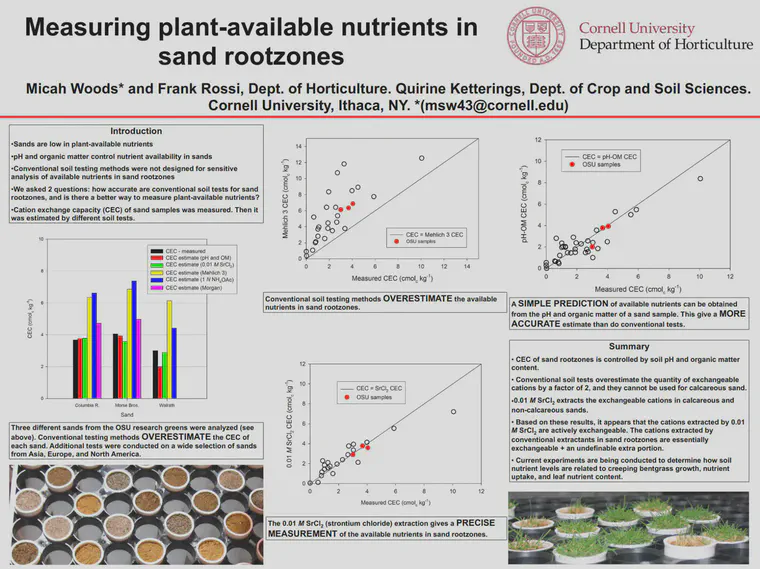Plant available nutrients in sand rootzones
Golf course putting greens and other high-use turf are generally grown in a sand rootzone. In Asia, many courses also have tees, fairways, and sometimes even rough areas plated with sand as well. This poster, which I prepared for the Oregon State University turfgrass field day in 2005, shows some interesting results on the measurement of plant-available nutrients in sand rootzones. In this poster I showed data looking specifically at calcium, magnesium, potassium, and sodium. Download the poster in PDF format by clicking here (1.6 MB).

The soil nutrient analysis (soil testing) procedures used at commercial laboratories were developed for soils that contain clay and silt particles. The sands used on golf courses and other fine turf areas are expressly selected to be relatively free of clay and silt. The data in this poster show that conventional soil test extractants such as Mehlich 3, normal ammonium acetate, and sodium acetate (Morgan extractant) overestimate the available nutrients in sand rootzones.
For the purpose of making fertilizer recommendations, it doesn’t really matter whether the extracted nutrients are plant available or not, as long as the fertilizer recommendations are accurate. But for estimating cation exchange capacity (CEC), it is clear that conventional soil tests overestimate the CEC of sand rootzones. Sand has an effective CEC of zero. Therefore, we can use an empirical relationship based on the contribution of soil organic matter to CEC. For a quick and accurate estimate of the CEC of a sand rootzone, use this equation:
$$ CEC = (-311 + (268(pH)))(\frac{OM}{1000}) $$
where,
$CEC$ units will be cmolc kg-1 which is equivalent to meq/100 g
$pH$ is the sample pH in a 1:1 ratio with H2O
$OM$ is the organic matter percentage of the sample, in % by mass
In tests conducted at Cornell University on sands collected from golf course putting greens around the world, we found that the simple equation above is a more accurate predictor of the sample CEC than are conventional soil tests. So if you really want to know how many nonacid cations (calcium, magnesium, potassium, and sodium) can be held in a sand rootzone, use that equation. All you need to know is the soil pH and organic matter content.